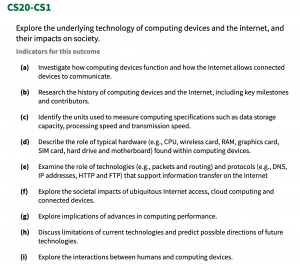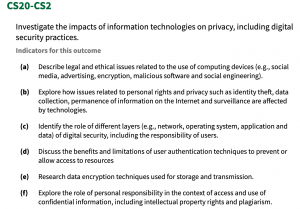Technology? In the Curriculum?
In class we have been talking a lot about the importance of digital literacy. As the majority of us would agree that digital citizenship and digital literacy should be taught and learned about at school since technology and the internet plays such a large role in society affecting our daily lives and that it can be dangerous if it is not used appropriately, but has the government thought it is important enough to become a standard topic taught in school by implementing learning about these topics through the teachers guideline, the Saskatchewan Curriculum? Lets take a look…
When taking a first, quick glance at the curriculum there is nothing to be found connecting directly to digital citizenship or digital literacy. There are no subject areas in any grades the specifically have to deal with these topics. Therefore, it makes sense that some high school students throughout Saskatchewan had the opportunity to take a digital citizenship/cyber safety course and some did not as it is not a subject to be found in the Saskatchewan Curriculum. There is technically 2 technology classes that can be taken in high school and I found taking my first, quick glance at the curriculum and that is Computer Science 20 and 30. However, taking a closer look at these courses by looking at the outcomes, these classes focused more on the scientific parts of technology then on the safety aspects of technology/internet. When looking at the computer science 20 course deeper I found these 2 outcomes caught my eye. 
I took a look into each of these outcomes even deeper by looking at the indicators for each of them and I found that the first outcome definitely focused more on the tech side of things. However, the second outcome had a few indicators that could be related back to digital literacy and cyber safety.


While taking a deeper look at the rest of the curriculum, I made connections to Ribble’s nine elements of digital citizenship to help certain aspects better related to digital citizenship and cyber safety. For example in all of the grade levels there are comprehend and respond outcomes where students are expected to be able to understand what they are reading and explain what that means; these sections can be connected back to the third (Digital Communication and Collaboration), eighth (Digital Rights and Responsibility), and the fifth element (Digital Fluency). For example the fifth element, digital fluency states, “Digital literacy includes the discussion of media literacy and the ability to discern good information from poor, such as ‘fake news’ from real news.”, this fits right into comprehending and responding as the students can practice their comprehending strategies by figuring out what they are reading on the internet is fake or real. Another example of a connection is through the third element, digital communication and collaboration as this one states that, “All users need to define how they will share their thoughts so that others understand the message.”, this fits perfectly for the responding part of the comprehending and responding topic as the students need to learn how they should respond to items on the internet; this can also be tied into the eighth (digital rights and responsibility) element and the fourth element (digital etiquette) as when responding to items on the internet their are rules and expectations that go with that, so the students can learn what those rules and expectations are.
This english example is just one way digital literacy can be incorporated into your teaching in the classroom. There are so many more ways, I could write a 50+ page essay about how to incorporate digital literacy with the curriculum but I don’t think any of you have the time nor the motivation to read that. Therefore, I will simply give this insight I found, there are thousands of ways to include digital literacy into the curriculum especially through using Ribble’s nine elements of digital citizenship. However, the curriculum does not give clear, literal guidance on how to do this so using the nine elements you may have to get a little bit creative of how to incorporate them. Another example if you haven’t caught on to what I am explaining so far is that also in multiple levels of the ELA curricula’s include creating multi-media presentations; therefore students are learning how to be digitally fluent (another element of digital citizenship) through creating these type of presentations that they may make in any subject area.
One last thing I will mention, is that not all your teaching of digital citizenships have to be through lessons. The past examples I have given you, have all been through adding ways to teach through another lesson, assignment type way. Although this is one great way to incorporate digital citizenship in your classroom it is not the only way. A different great way to do this is through classroom policies, such as do not share your password with any other students, do not have your phone/electronic device out while class is happening, and so much different policies that are including technology in anyway that could be teaching the students in indirect ways.
Let me know in the comments if you can think of different indirect ways some of your teachers incorporated digital citizenship in the classroom? Also I would love to know how your teacher approached teaching digital citizenship in your classes? Did they incorporate it with other class subjects? Did they teach it on an entire subject on its own?